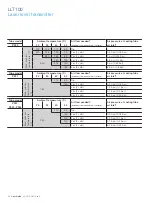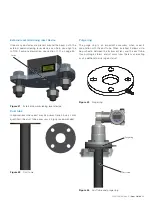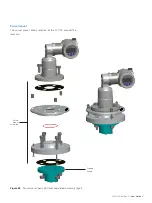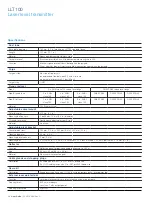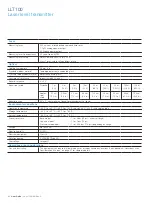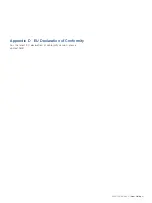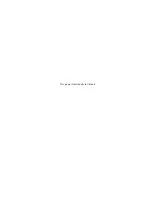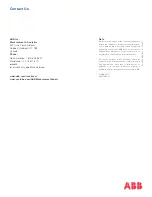
OI-LLT100-EN Rev. D |
User Guide
49
Ex safety aspects and IP protection
(North America)
Applicable standards
According to FM Approvals Standards which can assure
compliance with Essential Safety Requirements.
– FM 3600: Electrical Equipment for use in Hazardous
(Classified) Locations, General Requirements.
– FM 3615: Explosion proof Electrical Equipment.
– FM 3616: Dust ignition protected.
– FM 3810: Electrical and Electronic Test, Measuring and
Process Control Equipment.
– ANSI/ISA 60079-0 (general requirements)
– ANSI/UL 60079-1 (flameproof enclosure)
– ANSI/ISA 60079-26 (equipment with EPL Ga)
– ANSI/UL 60079-31 (equipment dust ignition protection by
enclosure)
– ANSI/ISA 12.27.01 (requirement for process sealing)
– ANSI/IEC 60529 (enclosure ingress protection)
– ANSI/NEMA 250: Enclosure for Electrical Equipment
(1000 volts maximum).
FM Certificate for class & divisions
– US: Class I, Division 1, Groups A, B, C, D T5 –50 °C ≤ Ta
≤ 85 °C
– US: Class I, Division 1, Groups A, B, C, D T6 –50 °C ≤ Ta
≤ 75 °C
– CAN: Class I, Division 1, Groups B, C, D T5 –50°C ≤ Ta
≤ 85 °C
– CAN: Class I, Division 1, Groups B, C, D T6 –50 °C ≤ Ta
≤ 75 °C
– US & CAN: Class II/III, Division 1, Groups E, F, G T5 –50 °C
≤ Ta ≤ 85 °C
– US & CAN: Class II/III, Division 1, Groups E, F, G T6 –50 °C
≤ Ta ≤ 75 °C
– (for LLT100.XX.A to G – all flanges except Triclover)
– Enclosure Type 4X – IP66/IP67
Certificates number:
FM16US0106X, FM16CA0060X
Explanation for class & division ratings:
The LLT100 Series laser level transmitters have been certified
by FM Approvals for the following class, divisions and gas
groups, hazardous classified locations, temperature class and
types of protection.
– Explosion proof (US) for Class I, Division 1, Groups A, B, C
and D, hazardous (classified) locations.
– Explosion proof (Canada) for Class I, Division 1, Groups B,
C, and D, hazardous (classified) locations.
– Dust ignition proof for Class II and III, Division 1, Groups E,
F, and G, hazardous (classified) locations.
– T5: Temperature class of the LLT100 (corresponding to
100 °C max) with a Ta from –50 °C to +85 °C
– T6: Temperature class of the LLT100 (corresponding to
85 °C max) with a Ta from –50 °C to +75 °C
– Enclosure Type 4X applications indoors/outdoors.
For proper field installation of LLT100 Series instruments, see
the related installation section.
For class and division marking for Canada, metric version of
the cable entry ports is not applicable.
For class and division marking for Canada, gas group A is not
applicable.
FM Certificate for Class & zones for gases:
– Class I, Zone 0/1, AEx/Ex db [op is T6 Ga] IIC T6...T5 Ga/Gb
–50 °C ≤ Ta ≤ +75 °C...+85 °C (for LLT100.XX.C to G only)
– Class I, Zone 1, AEx/Ex db [op is Ga] IIC T6...T5 Gb –50 °C
≤ Ta ≤ +75 °C...+85 °C (for LLT100.XX.A to B only)
– Enclosure Type 4X – IP66/IP67
Certificates number:
FM16US0106X, FM16CA0060X
Explanation for class & zone ratings:
– Explosion proof Class I, Zone 0/1 for gas groups IIC
– Zone 0/1: only the LLT100 process interface complies with
Zone 0. The rest of the instrument complies with Zone 1.
– Zone 1: the whole instrument can be installed in Zone 1.
– Ga/Gb: Part of the LLT100 complies with equipment
protection level “a” (the process interface). The remaining of
the LLT100 complies with Equipment protection level “b” for
Gas atmosphere.
– AEx/Ex db: Explosion protected by a flameproof enclosure
– [op is T6 Ga]: Optical intrinsic safety used for equipment
protection level “a” for Gas atmosphere
– T5: Temperature class of the LLT100 (corresponding to
100 °C max) with a Ta from –50 °C to +85 °C
– T6: Temperature class of the LLT100 (corresponding to
85 °C max) with a Ta from –50 °C to +75 °C
Enclosure Type 4X applications Indoors/ Outdoors.
For a correct installation in field of LLT100 Series, see the
related installation section.
Summary of Contents for LLT100
Page 8: ...This page intentionally left blank ...
Page 10: ...This page intentionally left blank ...
Page 18: ...This page intentionally left blank ...
Page 22: ...This page intentionally left blank ...
Page 26: ...This page intentionally left blank ...
Page 44: ...This page intentionally left blank ...
Page 50: ...This page intentionally left blank ...
Page 66: ...This page intentionally left blank ...
Page 67: ......




















